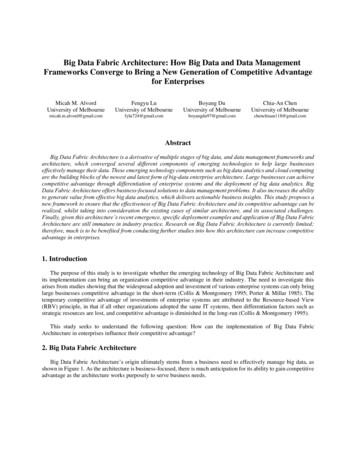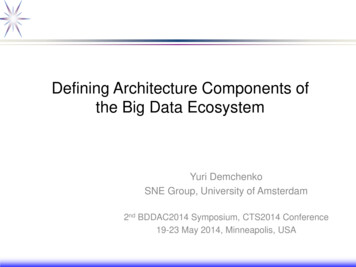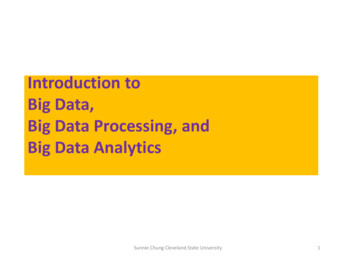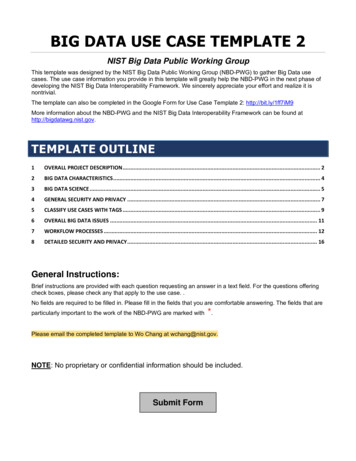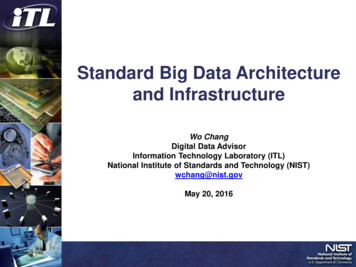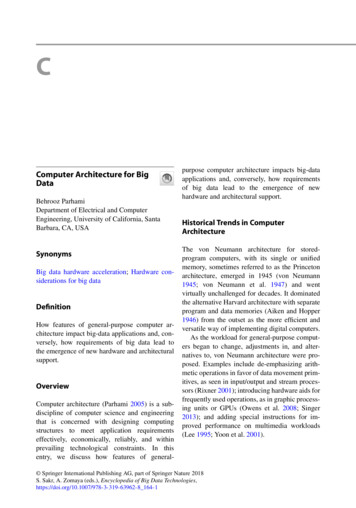
Transcription
CComputer Architecture for BigDataBehrooz ParhamiDepartment of Electrical and ComputerEngineering, University of California, SantaBarbara, CA, USASynonymsBig data hardware acceleration; Hardware considerations for big dataDefinitionHow features of general-purpose computer architecture impact big-data applications and, conversely, how requirements of big data lead tothe emergence of new hardware and architecturalsupport.OverviewComputer architecture (Parhami 2005) is a subdiscipline of computer science and engineeringthat is concerned with designing computingstructures to meet application requirementseffectively, economically, reliably, and withinprevailing technological constraints. In thisentry, we discuss how features of general-purpose computer architecture impacts big-dataapplications and, conversely, how requirementsof big data lead to the emergence of newhardware and architectural support.Historical Trends in ComputerArchitectureThe von Neumann architecture for storedprogram computers, with its single or unifiedmemory, sometimes referred to as the Princetonarchitecture, emerged in 1945 (von Neumann1945; von Neumann et al. 1947) and wentvirtually unchallenged for decades. It dominatedthe alternative Harvard architecture with separateprogram and data memories (Aiken and Hopper1946) from the outset as the more efficient andversatile way of implementing digital computers.As the workload for general-purpose computers began to change, adjustments in, and alternatives to, von Neumann architecture were proposed. Examples include de-emphasizing arithmetic operations in favor of data movement primitives, as seen in input/output and stream processors (Rixner 2001); introducing hardware aids forfrequently used operations, as in graphic processing units or GPUs (Owens et al. 2008; Singer2013); and adding special instructions for improved performance on multimedia workloads(Lee 1995; Yoon et al. 2001). Springer International Publishing AG, part of Springer Nature 2018S. Sakr, A. Zomaya (eds.), Encyclopedia of Big Data 62-8 164-1
2Recently, data-intensive applications necessitated another reassessment of the matchbetween prevalent architectures and applicationrequirements. The performance penalty of datahaving to be brought into the processor andsent back to memory through relatively narrowtransfer channels was variously dubbed the “vonNeumann bottleneck” (Markgraf 2007) andthe “memory wall” (McKee 2004; Wulf andMcKee 1995). Memory data transfer rates aremeasured in GB/s in modern machines, whereasthe processing rates can be three or more decimalorders of magnitude higher.The term “non-von” (Shaw 1982) was coinedto characterize a large category of machines thatrelaxed one or more of the defining features ofthe von Neumann architecture, so as to alleviatesome of the perceived problems. Use of cachememories (Smith 1982), often in multiple levels,eased the von Neumann bottleneck for a while,but the bottleneck reemerged, as the higher cachedata transfer bandwidth became inadequate andapplications that lacked or had relatively limitedlocality of reference emerged. Memory interleaving and memory-access pipelining, pioneeredby IBM (Smotherman 2010) and later used extensively in Cray supercomputers, was the nextlogical step.Extrapolating a bit from Fig. 1 (which coversthe period 1985–2010), and using round numbers, the total effect of architectural innovationshas been a 100-fold gain in performance, ontop of another factor-of-100 improvement due tofaster gates and circuits (Danowitz et al. 2012).Both growth rates in Fig. 1 show signs of slowing down, so that future gains to support therising processing need of big data will have tocome, at least in part, from other sources. In thetechnology arena, use of emerging technologieswill provide some boost for specific applications. An intriguing option is resurrecting hybriddigital/analog computing, which was sidelinedlong ago in favor of all-digital systems. Architecturally, specialization is one possible avenuefor maintaining the performance growth rate, asare massively parallel and in-memory or nearmemory computing.Computer Architecture for Big DataHow Big Data Affects ComputerArchitectureThe current age of big data (Chen and Zhang2014; Hu et al. 2014) has once again exposedthe von Neumann bottleneck, forcing computerarchitects to seek new solutions to the age-oldproblem, which has become much more serious.Processing speed continues to rise exponentially,while memory bandwidth increases at a muchslower pace.It is by now understood that big data is different from “lots of data.” It is sometimes definedin terms of the attributes of volume, variety,velocity, and veracity, known as the “4Vs” (or“5 Vs,” if we also include value). Dealing withbig data requires big storage, big-data processingcapability, and big communication bandwidth.The first two (storage and data processing) directly affect the architecture of the nodes holdingand processing the data. The part of communication that is internode is separately consideredin this encyclopedia. However, there is also theissue of intranode communication represented inbuses and networks-on-chip that belong to ourarchitectural discussion here.In addition to data volume, the type of data tobe handled is also changing from structured data,as reflected, for example, in relational databases,to semi-structured and unstructured data. Whilethis change has some negative effects in terms ofmaking traditional and well-understood databasetechnologies obsolete, it also opens up the possibility of using scalable processing platformsmade of commodity hardware as part of thecloud-computing infrastructure. Massive unstructured data sets can be stored in distributed filesystems, such as the ones designed in connectionwith Hadoop (Shafer et al. 2010) or SQL/noSQL(Cattell 2011).In addition to the challenges associated withrising storage requirements and data access bandwidth, the processing load grows with data volume because of various needs. These are: Encryption and decryption Compression and decompression Sampling and summarization
Computer Architecture for Big Data3CComputer Architecture for Big Data, Fig. 1 Technology advances and architectural innovations each contributed afactor of 100 improvement in processor performance over three decades. (Danowitz et al. 2012) Visualization and graphingSorting and searchingIndexing and query processingClassification and data miningDeduction and learningThe first four items above, which are differentforms of data translation, are discussed in the nextsection. The other items, viz., data transformations, will be discussed subsequently.Architectural Aids to DataTranslationsMany important data translations are handledby endowing a general-purpose architecture withsuitable accelerator units deployed as coprocessors. Such accelerators are ideally custom integrated circuits, whose designs are fully optimizedfor their intended functions. However, in viewof rapid advances in capabilities, performance,and energy efficiency of field-programmable gatearrays (Kuon et al. 2008), a vast majority ofmodern accelerators reported in the literature arebuilt on FPGA circuits.Accelerators for encryption and decryptionalgorithms have a long history (Bossuet et al.2013). The binary choice of custom-designedVLSI or general-purpose processing for cryptographic computations has expanded to include avariety of intermediate solutions which includethe use of FPGAs and GPUs. The best solutionfor an application domain depends not only onthe required data rates and the crypto scheme, butalso on power, area, and reliability requirements.Data compression (Storer 1988) allows us totrade processing time and resources for savings instorage requirements. While any type of data canbe compressed (e.g., text compression), massivesizes of video files make them a prime target forcompression. With the emergence of video compression standards (Le Gall 1991), much efforthas been expended to implement the standardson special-purpose hardware (Pirsch et al. 1995),offering orders of magnitude speed improvementover general-purpose programmed implementations.Both sampling and summarization aim to reduce data volume while still allowing the operations of interest to be performed with reasonableprecision. An alternative to post-collection reduction of data volume is to apply compression during data collection, an approach that in the case ofsensor data collection is known as compressivesensing (Baraniuk 2007). Compressive sensing,
4when applicable, not only saves on processingtime but also reduces transmission bandwidthand storage requirements. There are some mathematical underpinnings common to compressivesensing techniques, but at the implementationlevel, the methods and algorithms are by andlarge application-dependent.Data visualization (Ward et al. 2010) refers tothe production of graphical representation of datafor better understanding of hidden structures andrelationships. It may provide the only reasonablehope for understanding massive amounts of data,although machine learning is a complementaryand competing method of late. Several visualization accelerators were implemented in the late1990s (e.g., Scott et al. 1998), but the moderntrend is to use FPGA and cluster-based methods.Architectural Aids to DataTransformationsSorting is an extremely important primitive thatis time-consuming for large data sets. It is usedin a wide array of contexts, which includes facilitating subsequent searching operations. It can beaccelerated in a variety of ways, from buildingmore efficient data paths and memory accessschemes, in order to make conventional sortingalgorithms run faster, to the extreme of usinghardware sorting networks (Mueller et al. 2012;Parhami 1999).Indexing is one of the most important operations for large data sets, such as those maintained and processed by Google. Indexing andquery processing have been targeted for acceleration within large-scale database implementations (Casper and Olukotun 2014; Govindarajuet al. 2004). Given the dominance of relationaldatabases in numerous application contexts, a variety of acceleration methods have been proposedfor operations on such databases (e.g., Bandi etal. 2004). Hardware components used in realizingsuch accelerators include both FPGAs and GPUs.Hardware aids for classification are as diverseas classification algorithms and their underlying applications. A prime example in Internetrouting is packet classification (Taylor 2005),Computer Architecture for Big Datawhich is needed when various kinds of packets,arriving at extremely high rates, must be separated for appropriate handling. Modern hardware aids for packet classification use customarrays for pipelined network processing, contentaddressable memories (Liu et al. 2010), GPUs(Owens et al. 2008), or tensor processing units(Sato et al. 2017). Data mining, the process ofgenerating new information by examining largedata sets, has also been targeted for acceleration(Sklyarov et al. 2015), and it can benefit fromsimilar highly parallel processing approaches.Also falling under such acceleration schemes areaids and accelerators for processing large graphs(Lee et al. 2017).The earliest form of deduction engines weretheorem provers. An important application ofautomatic deduction and proof is in hardware verification (Cyrluk et al. 1995). In recent years, machine learning has emerged as an important toolfor improving the performance of conventionalsystems and for developing novel methods oftackling conceptually difficult problems. Gameplaying systems (Chen 2016) constitute important testbeds for evaluating various approaches tomachine learning and their associated hardwareacceleration mechanisms. This is a field that hasjust started its meteoric rise and bears watchingfor future applications.Memory, Processing,and InterconnectsIn both general-purpose and special-purpose systems interacting with big data, the three interconnected challenges of providing adequate memory capacity, supplying the requisite processingpower, and enabling high-bandwidth data movements between the various data-handling nodesmust be tackled (Hilbert and Lopez 2011).The memory problem can be approachedusing a combination of established and noveltechnologies, including nonvolatile RAM, 3Dstacking of memory cells, processing in memory,content-addressable memory, and a variety ofnovel (nanoelectronics or biologically inspired)technologies. We won’t dwell on the memory
Computer Architecture for Big Dataarchitecture in this entry, because the memorychallenge is addressed in other articles (see theCross-References).Many established methods exist for increasingthe data-handling capability of a processingnode. The architectural nomenclature includessuperscalar and VLIW organizations, collectivelyknown as instruction-level parallelism (Rau andFisher 1993), hardware multithreading (Eggerset al. 1997), multicore parallelism (Gepnerand Kowalik 2006), domain-specific hardwareaccelerators (examples cited earlier in this entry),transactional memory (Herlihy and Moss 1993),and SIMD/vector architectural or instructionset extensions (Lee 1995; Yoon et al. 2001).A complete discussion of all these methodsis beyond the scope of this entry, but muchpertinent information can be found elsewherein this encyclopedia.Intranode communication is achieved throughhigh-bandwidth bus systems (Hall et al. 2000)and, increasingly, for multicore processors andsystems-on-chip, by means of on-chip networks(Benini and De Micheli 2002). Interconnectionbandwidth and latency rank high, along withmemory bandwidth, among hardware capabilitiesneeded for effective handling of big-data applications, which are increasingly implemented usingparallel and distributed processing. Considerations in this domain are discussed in the entry“Parallel Processing for Big Data.”5will speed up the process of trickling down ofarchitectural innovations from supercomputers,which have always led the way, into servers oreven personal computers, which now benefit fromparallel processing and, in some cases, massiveparallelism.Several studies have been performed about thedirection of computer architecture in view of newapplication domains and technological developments in the twenty-first century (e.g., Ceze et al.2016; Stanford 2012). Since much of the processing schemes for big data will be provided throughthe cloud, directions of cloud computing andassociated hardware acceleration mechanisms become relevant to our discussion here (Caulfieldet al. 2016). Advanced graphics processors (e.g.,Nvidia 2016) will continue to play a key role inproviding the needed computational capabilitiesfor data-intensive applications requiring heavynumerical calculations. Application-specific accelerators for machine learning (Sato et al. 2017),and, more generally, various forms of specialization, constitute another important avenue ofarchitectural advances for the big-data universe.Cross-References Energy Implications of Big Data Parallel Processing with Big Data Storage Hierarchies for Big Data Storage Technologies for Big DataFuture DirectionsReferencesThe field of computer architecture has advancedfor several decades along the mainstream lineof analyzing general applications and makinghardware faster and more efficient in handlingthe common case while being less concernedwith rare cases which have limited impact onperformance. Big data both validates and challenges this assumption. It validates it in the sensethat certain data-handling primitives arise in allcontexts, regardless of the nature of the data orits volume. It challenges the assumption by virtueof the von-Neumann bottleneck or memory-wallnotions discussed earlier. The age of big dataAiken HH, Hopper GM (1946) The automatic sequencecontrolled calculator – I. Electr Eng 65(8–9):384–391Bandi N, Sun C, Agrawal D, El Abbadi A (2004) Hardware acceleration in commercial databases: a casestudy of spatial operations. In: Proceedings of the international conference on very large data bases, Toronto,pp 1021–1032Baraniuk R (2007) Compressive sensing. IEEE SignalProcess Mag 24(4):118–121Benini L, De Micheli G (2002) Networks on chips: a newSoC paradigm. IEEE Comput 35(1):70–78Bossuet L, Grand M, Gaspar L, Fischer V, Gogniat G(2013) Architectures of flexible symmetric key cryptoengines – a survey: from hardware coprocessor toC
6multi-crypto-processor system on chip. ACM ComputSurv 45(4):41Casper J, Olukotun K (2014) Hardware acceleration ofdatabase operations. In: Proceedings of ACM/SIGDAinternational symposium on field-programmable gatearrays, Monterey, CA, pp 151–160Cattell R (2011) Scalable SQL and NoSQL data stores.ACM SIGMOD Rec 39(4):12–27Caulfield AM et al (2016) A cloud-scale accelerationarchitecture. In: Proceedings of 49th IEEE/ACM international symposium on microarchitecture, Orlando,FL, pp 1–13Ceze L, Hill MD, Wenisch TE (2016) Arch2030: a visionof computer architecture research over the next 15years, Computing Community Consortium. /12/15447-CCC-ARCH-2030-report-v3-1-1.pdfChen JX (2016) The evolution of computing: AlphaGo.Comput Sci Eng 18(4):4–7Chen CLP, Zhang C-Y (2014) Data-intensive applications,challenges, techniques and technologies: a survey onbig data. Inf Sci 275:314–347Cyrluk D, Rajan S, Shankar N, Srivas MK (1995) Effective theorem proving for hardware verification. In:Theorem provers in circuit design. Springer, Berlin, pp203–222Danowitz A, Kelley K, Mao J, Stevenson JP, HorowitzM (2012) CPU DB: recording microprocessor history.Commun ACM 55(4):55–63Eggers SJ, Emer JS, Levy HM, Lo JL, Stamm RL, TullsenDM (1997) Simultaneous multithreading: a platformfor next-generation processors. IEEE Micro 17(5):12–19Gepner P, Kowalik MF (2006) Multi-core processors:new way to achieve high system performance. In: Proceedings of IEEE international symposium on parallelcomputing in electrical engineering, Bialystok, pp 9–13Govindaraju NK, Lloyd B, Wang W, Lin M, Manocha D(2004) Fast computation of database operations usinggraphics processors. In: Proceedings of the ACM SIGMOD international conference on management of data,Paris, pp 215–226Hall SH, Hall GW, McCall JA (2000) High-speed digitalsystem design: a handbook of interconnect theory anddesign practices. Wiley, New YorkHerlihy M, Moss JEB (1993) Transactional memory:architectural support for lock-free data structures. In:Proceedings of the international symposium on computer architecture, San Diego, CA, pp 289–300Hilbert M, Lopez P (2011) The world’s technologicalcapacity to store, communicate, and compute information. Science 332:60–65Hu H, Wen Y, Chua T-S, Li X (2014) Toward scalablesystems for big data analytics: a technology tutorial.IEEE Access 2:652–687Kuon I, Tessier R, Rose J (2008) FPGA architecture:survey and challenges. Found Trends Electron DesAutom 2(2):135–253Computer Architecture for Big DataLe Gall D (1991) MPEG: a video compression standardfor multimedia applications. Commun ACM 34(4):46–58Lee RB (1995) Accelerating multimedia with enhancedmicroprocessors. IEEE Micro 15(2):22–32Lee J, Kim H, Yoo S, Choi K, Hofstee HP, Nam GJ,Nutter MR, Jamsek D (2017) ExtraV: boosting graphprocessing near storage with a coherent accelerator.Proc VLDB Endowment 10(12):1706–1717Liu AX, Meiners CR, Torng E (2010) TCAM razor: asystematic approach towards minimizing packet classifiers in TCAMs. IEEE/ACM Trans Networking 18(2):490–500Markgraf JD (2007) The von Neumann Bottleneck. Online source that is no longer accessible (will find areplacement for this reference during revisions)McKee SA (2004) Reflections on the memory wall. In:Proceedings of the conference on computing frontiers,Ischia, pp 162–167Mueller R, Teubner J, Alonso G (2012) Sorting networkson FPGAs. Int J Very Large Data Bases 21(1):1–23Nvidia (2016) Nvidia Tesla P100: infinite compute powerfor the modern data center – technical overview.On-line document. teslap100-techoverview.pdf. Accessed18 Feb 2018Owens JD et al (2008) GPU computing. Proc IEEE96(5):879–899Parhami B (1999) Chapter 7: Sorting networks. In: Introduction to parallel processing: algorithms and architectures. Plenum Press, New York, pp 129–147Parhami B (2005) Computer architecture: from microprocessors to supercomputers. Oxford University Press,New YorkPirsch P, Demassieux N, Gehrke W (1995) VLSI architectures for video compression – a survey. Proc IEEE83(2):220–246Rau BR, Fisher JA (1993) Instruction-level parallel processing: history, overview, and perspective. J Supercomput 7(1–2):9–50Rixner S (2001) Stream processor architecture. Kluwer,BostonSato K, Young C, Patterson D (2017) An in-depthlook at Google’s first tensor processing unit, googlecloud big data and machine learning blog, May12. On-line document. it-tpu. Accessed 18 Feb 2018Scott ND, Olsen DM, Gannett EW (1998) An overview ofthe visualize FX graphic accelerator hardware. HewlettPackard J 49:28–29Shafer J, Rixner S, Cox AL (2010) The Hadoop distributed filesystem: balancing portability and performance. In: Proceedings of the IEEE international symposium on performance analysis of systems & software, White Plains, NY, pp 122–133Shaw DE (1982) The non-von supercomputer, ColumbiaUniversity technical report, on-line document. 914.Accessed 18 Feb 2018
Computer Architecture for Big DataSinger G (2013) The history of the modern graphics processor, TechSpot on-line article. -gpu/. Accessed 18 Feb2018Sklyarov V et al (2015) Hardware accelerators for information retrieval and data mining. In: Proceedings of theIEEE conference on information and communicationtechnology research, Bali, pp 202–205Smith AJ (1982) Cache memories. ACM Comput Surv14(8):473–530Smotherman M (2010) IBM stretch (7030) – aggressive uniprocessor parallelism. On-line document.http://people.cs.clemson.edu/ mark/stretch.html. Accessed 18 Feb 2018Stanford University (2012) 21st century computer architecture: a community white paper, on-line document.http://csl.stanford.edu/ .whitepaper.pdf. Accessed 18 Feb2018Storer J (1988) Data compression. Computer SciencePress, RockvilleTaylor DE (2005) Survey and taxonomy of packet classification techniques. ACM Comput Surv 37(3):238–2757von Neumann J (1945) First draft of a report onthe EDVAC, University of Pennsylvania. On-linedocument. ss.stanford.edu/ godfrey/vonNeumann/vnedvac.pdf. Accessed 14 Feb 2018von Neumann J, Burks AW, Goldstine HH (1947) Preliminary discussion of the logical design of an electroniccomputing instrument. Institute for Advanced Study,PrincetonWard MO, Grinstein G, Keim D (2010) Interactive data visualization: foundations, techniques, and applications.CRC Press, NatickWulf W, McKee S (1995) Hitting the wall: implications ofthe obvious. ACM Comput Archit News 23(1):20–24Yoon C-W, Woo R, Kook J, Lee S-J, Lee K, Yoo H-J(2001) An 80/20-MHz 160-mW multimedia processorintegrated with embedded DRAM, MPEG-4 accelerator, and 3-D rendering engine for mobile applications.IEEE J Solid State Circuits 36(11):1758–1767C
Big data hardware acceleration; Hardware con-siderations for big data Definition How features of general-purpose computer ar-chitecture impact big-data applications and, con-versely, how requirements of big data lead to the emergence of new hardware and architectural support. Overview Comput
